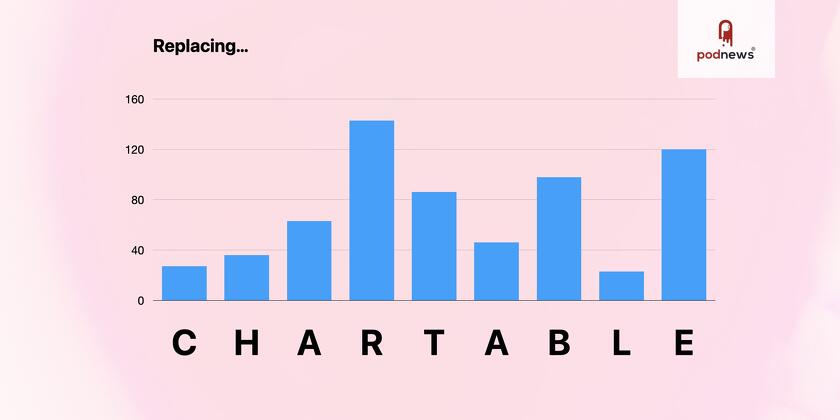
Replacing Chartable - alternatives for reviews, marketing and analysis

This article is at least a year old
Now we’ve learnt that Chartable will close on December 12, you might be wondering what to use.
It all depends on what you use Chartable for - it offered quite a lot of things, so it’s quite hard to work out what you were using it for. So, below, here’s what it did - and companies to check out.
See podcast charts across the world
Rephonic keeps a full list for Apple Podcasts, for Spotify, and for YouTube.
Podfollow has launched Podfollow Charts, a chart tracking service which lets you search for your show. It includes chart history, is free, and currently covers five countries.
Ausha has launched Ausha Charts which covers sub-categories and all countries for Apple and Spotify. The tool is currently a chart (and category) browser, and doesn’t let you search your show.
As a paid service, Podgagement has launched a rankings service with access to nearly 34,000 charts across the world for the last five years, and enables podcasters to monitor your popularity across multiple charts, apps and regions.
Where is my podcast in the charts?
You can claim your podcast for free at Rephonic, and you get free access to all your metrics. Here’s what our daily podcast looks like.
While Rephonic recommends signing up with OP3, this is no longer a requirement to claim your podcast.
PodStatus or Podgagement are paid services that also offer this.
What are the download stats for my podcast?
Your podcast host is the best place for this. But if you need another opinion, you can use OP3 for free. That automatically makes your stats public - here’s ours. (Your stats are public with YouTube, Castbox and Spotify anyway - and you don’t have anything to hide, right?)
You can also get free independent stats for your podcast from Podtrac.
Blubrry offers free podcast statistics to qualifying podcasters, and if you don’t qualify, it’s still a cheap $5/month.\
For enterprises, CoHost offers analytics and demographics, wherever you’re hosted.
How do I get demographic information about my listeners?
Ask them. Get them to do a web survey. That’s really the only good way. (Google Forms will do the trick; web surveys are also included in some Podpage packages).
You can get demographic information from Spotify for Creators. It’s in your dashboard. Caution though it’s for Spotify only, which skews younger and less affluent than Apple users.
For enterprises, CoHost offers very detailed demographics, even including the types of companies your listeners work at.
What do my reviews for my podcast say?
In Apple Podcasts, you can only see reviews from your home country, so that’s not very helpful.
Instead, Rephonic will help you here, too, if you claim your podcast - not just from Apple Podcasts, either - the system pulls in reviews from Podchaser, Podcast Addict, Audible, Castbox, and stars from Spotify.
Paid tools for getting all your reviews include Podgagement and PodStatus. (PodStatus covers iVoox, which is helpful if you have a podcast in Spanish).
How can I replace my SmartLinks and SmartPromos?
SmartLinks and SmartPromos were a way to measure your marketing in things like newsletters, social media posts and other things - and see how many people went on to listen. You used different links in every place.
Linkfire for Podcasts will do this for Apple Podcasts - so you can directly see what works for you, but only in Apple. Spotify has its own conversion metrics that are rolling out: but you can use these links in Linkfire too. Linkfire has a free tier. Covering both Spotify and Apple is probably enough - it’ll capture the majority of your plays.
If you’ve budget, CoHost Tracking Links are a direct replacement for SmartLinks.
For SmartPromos, Magellan AI’s Pod to Pod Attribution is a good fit.
If all you want is a simple link to promote, then (in our humble opinion) you want… a website. Use that - buy a domain, point it to either a) your Buzzsprout, Captivate or Transistor podcast page, b) something like Podpage or Transistor’s free podcast websites (wherever you’re hosted), or c) go and find a web designer to make you a nice podcast website, or use Squarespace or something.
If you choose to ignore that advice, then a) you’re wrong, but b) we’d recommend either Podfollow or Episodes.fm (they both do episode sharing too).
You could use Spotify’s podlink, but it’s run by Spotify, the company closing Chartable, so…
How do I replace the consumption data?
Chartable only gave consumption data (how long a listener actually listened) for Spotify, and you can get that from the Spotify for Podcasters dashboard. Additionally, you can get Apple Podcasts data from the Apple Podcasts Connect dashboard, and YouTube data from YouTube Studio.
If you’ve budget, the Bumper Dashboard is available to clients of Bumper.
How do I raise a glass to Chartable?
We first met co-founders Harish Agarwal and Dave Zohrob at Podfest and then Podcast Movement in 2019. While they left Spotify a while back, and are now (spit!) doing things outside podcasting, we appreciate their cool tools for the industry. The fact we’ve had to write a long post like this with lots of different companies to replace theirs is testament to their ingenuity. Cheers to you both.































































































